Ribeye steak is a favorite among meat lovers for its rich marbling and tenderness. This cut comes from the rib section, specifically the longissimus dorsi muscle, offering a flavorful experience perfect for grilling or pan-searing. To make the most of your ribeye, season it well and guarantee you cook it to medium-rare at around 130°F. After cooking, letting it rest enhances the juiciness. If you're curious about preparing it, there's plenty more to explore!
History
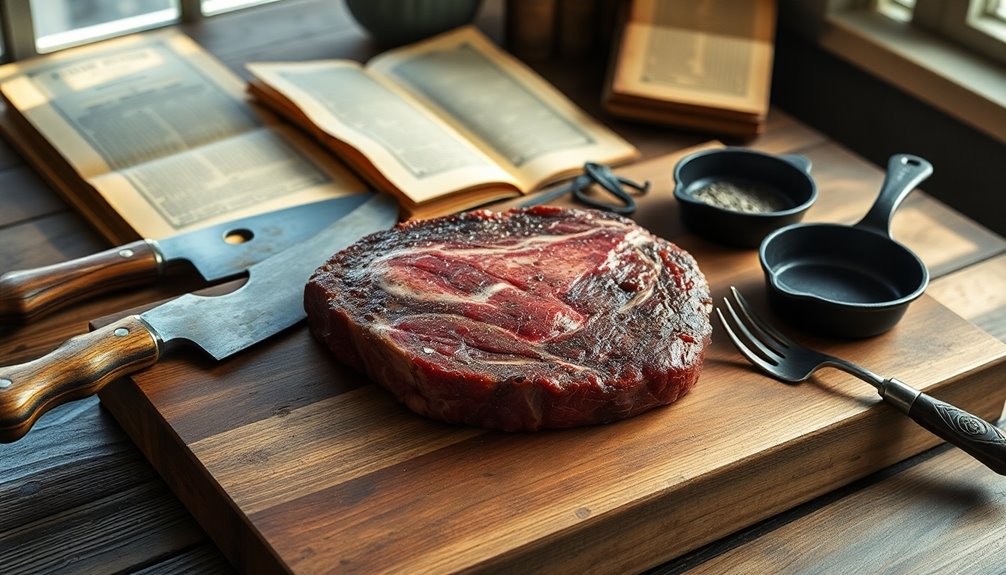
Although ribeye steak is beloved today, its history traces back to its origin in the rib section of the beef, specifically from the longissimus dorsi muscle. This cut's tenderness and rich marbling make it a sought-after choice for steak lovers.
The term "ribeye" combines "rib" and "eye," referring to the central, bone-free portion. In culinary traditions, you might encounter it as "entrecôte" in French or "ojo de bife" in Argentina.
Its popularity soared in the United States during the mid-20th century, aligning with the rise of grilling and backyard barbecues. Known for being a flavorful steak, the juicy ribeye offers an unmatched taste experience, thanks to its marbling that melts beautifully during cooking.
Recipe
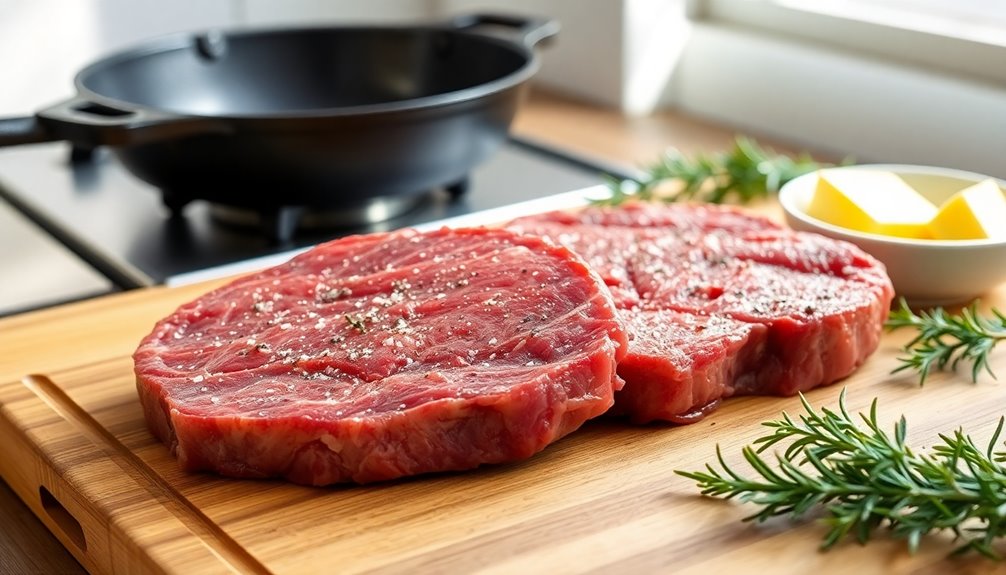
Ingredients:
- 2 ribeye steaks (1 to 1.5 inches thick)
- Salt
- Black pepper
- Butter (optional, for resting)
- Fresh herbs (optional, for flavor)
Cooking Instructions:
To cook your ribeye steaks, start by preheating your cast iron skillet over high heat or your grill to high temperature.
While the skillet or grill is heating, season both sides of the steaks generously with salt and black pepper.
Once the skillet is hot, add the steaks and sear them for about 4-5 minutes on each side, or until a nice crust forms and the internal temperature reaches your desired doneness.
If you're using butter, place a pat on top of the steaks during the final minute of cooking.
After removing the steaks from the heat, let them rest for 5 to 10 minutes, allowing the juices to redistribute before slicing.
Extra Tips:
When cooking ribeye steaks, it's essential to avoid overcrowding the skillet or grill to maintain high heat and achieve that perfect crust.
If you're cooking multiple steaks, consider doing them in batches.
Additionally, using a meat thermometer can help you achieve precise doneness without guesswork.
Finally, if you're looking to elevate the flavor, consider marinating the steaks for a few hours beforehand or adding garlic or herbs to the butter for added richness while resting.
Enjoy your perfectly cooked ribeye!
Cooking Steps
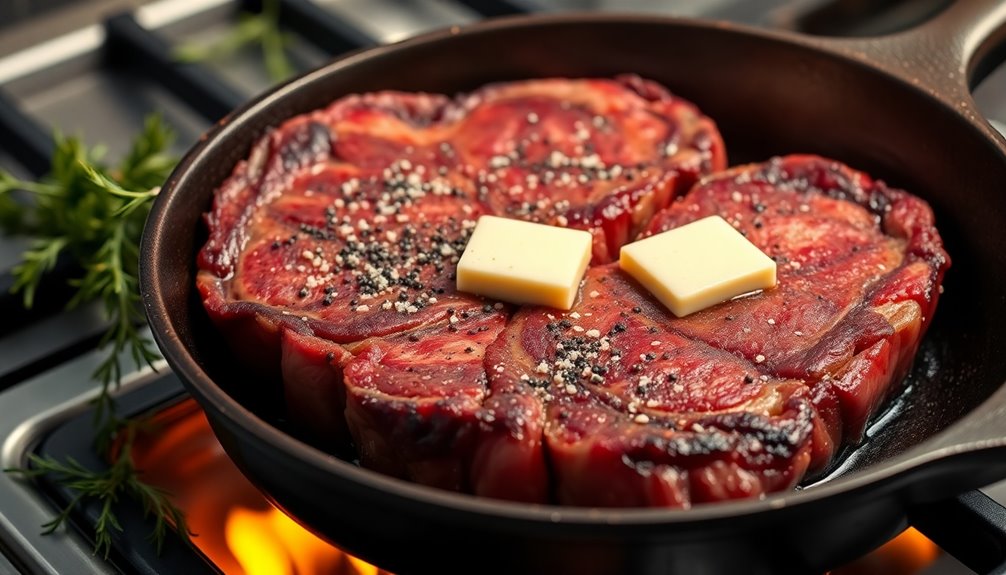
When you're ready to cook your ribeye, start by selecting a quality cut and seasoning it generously with salt.
Searing it over high heat locks in flavor and creates that perfect crust.
After cooking, let it rest properly before slicing against the grain for the best texture.
Step 1. Select a Quality Ribeye
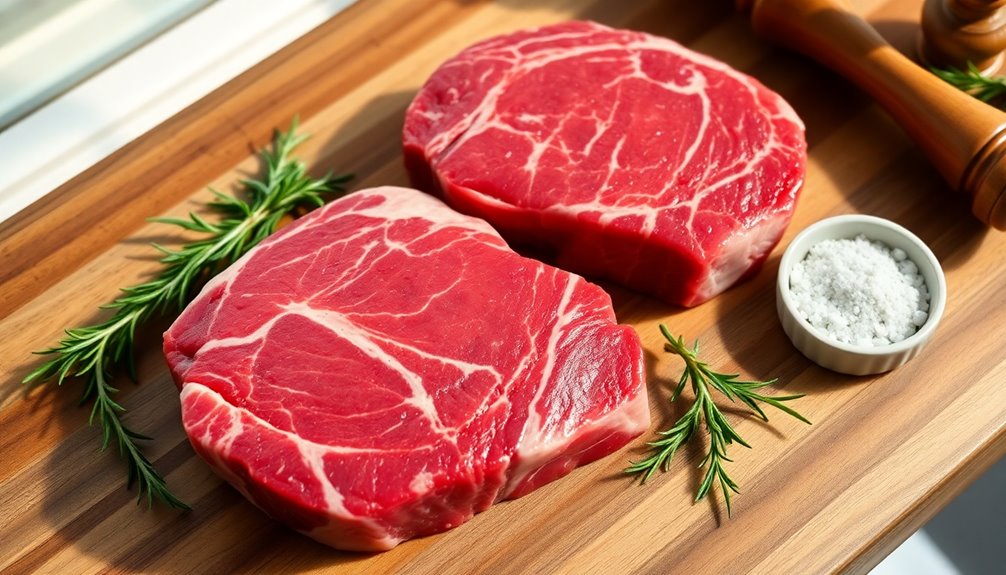
To select a quality ribeye steak, focus on thickness and marbling, as these factors directly impact tenderness and flavor. Aim for ribeye steaks that are at least 1-inch thick and feature even marbling, which guarantees juicy steaks.
Look for cuts sourced from the upper rib cage, specifically between the sixth and twelfth ribs, for the best quality. Before cooking, bring your steak to room temperature to guarantee even cooking and avoid a cold center.
When it's time to cook, use high-heat methods like grilling or pan-searing, aiming for an internal temperature of 130°F for medium-rare doneness.
Finally, season your steaks minimally with black pepper and kosher salt, letting the meat's natural flavor shine.
Step 2. Season Generously With Salt
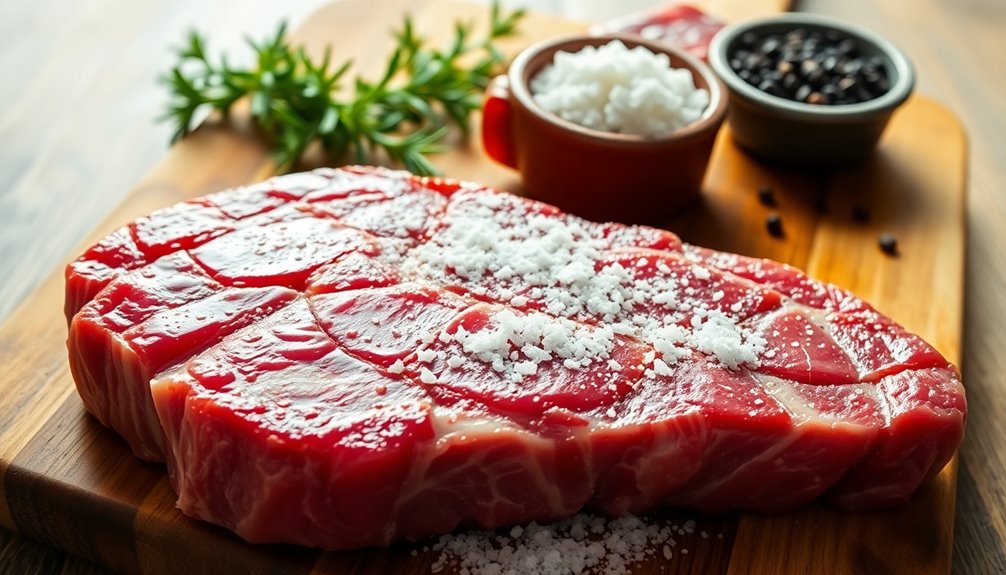
Seasoning your ribeye steak generously with kosher salt is an essential step that greatly enhances its flavor and tenderness.
Salt helps break down proteins, allowing moisture retention and even juice distribution throughout the meat. For ideal seasoning, use about 1 teaspoon of kosher salt per pound of ribeye, ensuring an even coating across the surface.
If possible, salt your steak up to 12 hours in advance, as this gives the salt time to penetrate the meat, considerably improving flavor and tenderness.
After salting, let the steak sit at room temperature for about 30 minutes before cooking. This not only promotes even cooking but also enhances flavor absorption, making your ribeye steak a truly delicious experience.
Step 3. Sear Over High Heat
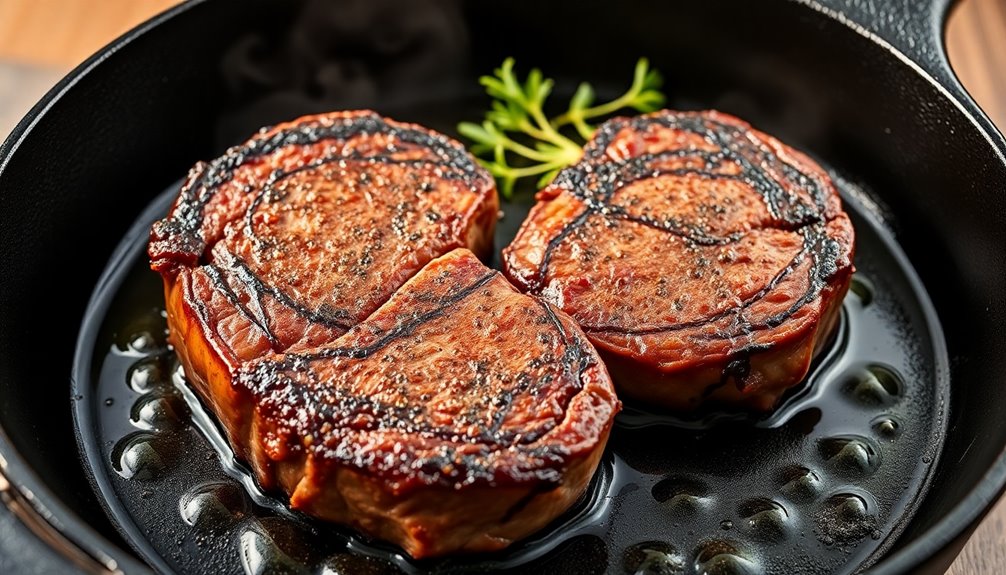
Searing your ribeye steak over high heat is crucial for developing a rich, flavorful crust. Preheat your cast iron pan to around 500°F and add a drizzle of olive oil.
Once the oil shimmers, place your ribeye steak in the pan. Sear it for about 3 minutes on one side until it achieves a nice brown color, then flip it and sear the other side for another 3 minutes.
This method keeps the inside juicy and perfectly cooked to medium rare without burning the exterior. Resist the urge to press down on the steak, as this can dry it out.
After searing, let the steak rest for 5 to 10 minutes to guarantee the juices redistribute for maximum flavor.
Step 4. Let It Rest Properly
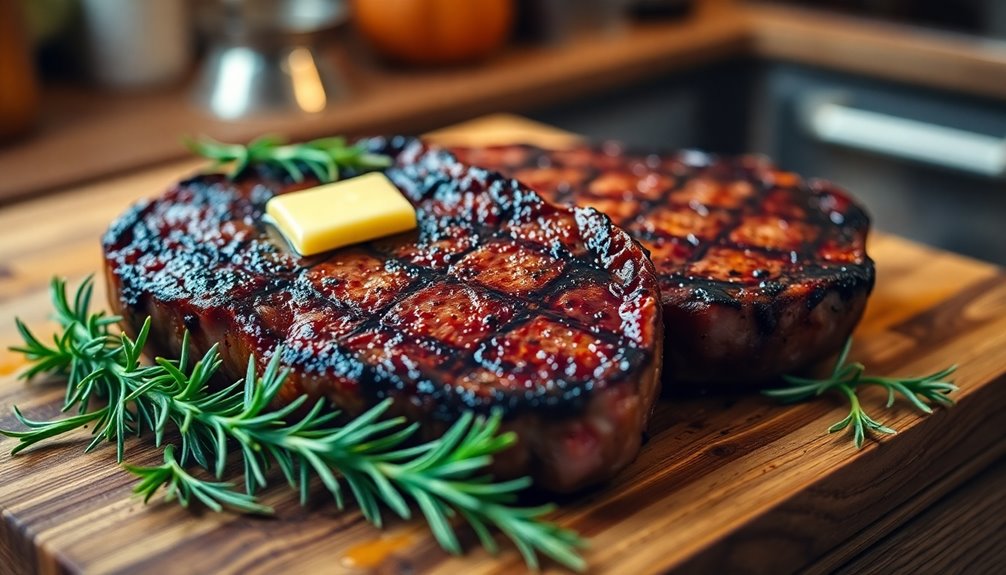
Letting your ribeye steak rest for 5 to 10 minutes is essential for a perfect finish. This resting period allows the juices to redistribute throughout the meat, making it more tender and flavorful.
Cover your steaks loosely with aluminum foil to retain warmth without trapping steam, which could lead to a soggy crust.
Remember, during resting, the internal temperature may rise by about 5°F, so pull your steak off the heat just before it hits your desired doneness.
Proper resting is important for preventing the juices from spilling when you cut into the steak, ensuring each bite remains juicy and satisfying.
Enjoy the enhanced flavor and texture that comes from this simple yet critical step!
Step 5. Slice Against the Grain
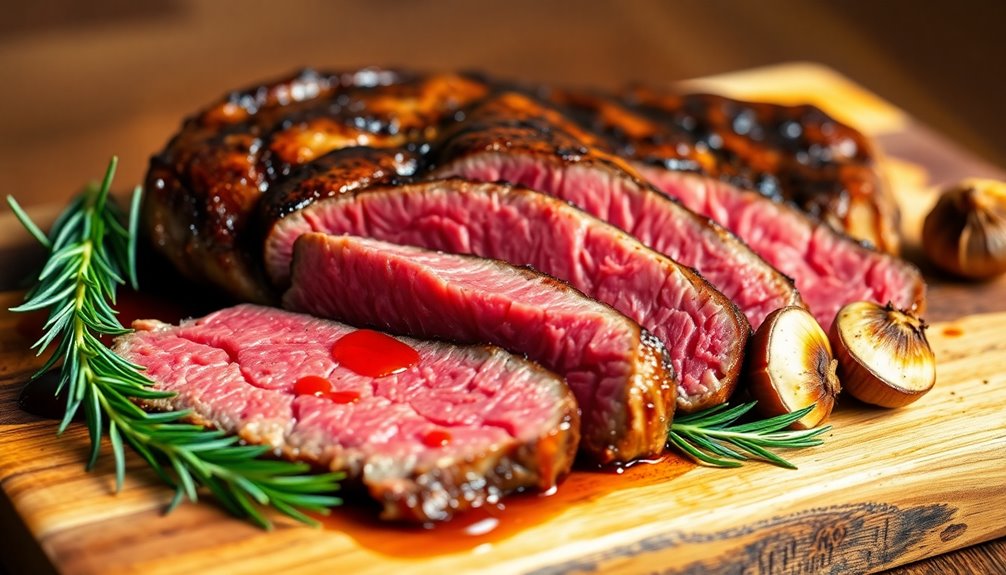
Once your ribeye steak has rested, slicing against the grain is essential for achieving that tender bite you crave.
To identify the grain, look for the striations in the meat that indicate the direction of the muscle fibers. Using a sharp knife, cut perpendicular to these lines to shorten the fibers, enhancing tenderness.
When working with ribeye steaks, the marbling adds flavor and juiciness, so thin slices are key to maximizing your enjoyment. Aim for even, thin slices to guarantee each bite is juicy and full of flavor.
This technique not only makes the steak easier to chew but also elevates your dining experience. Enjoy your perfectly sliced ribeye!
Final Thoughts
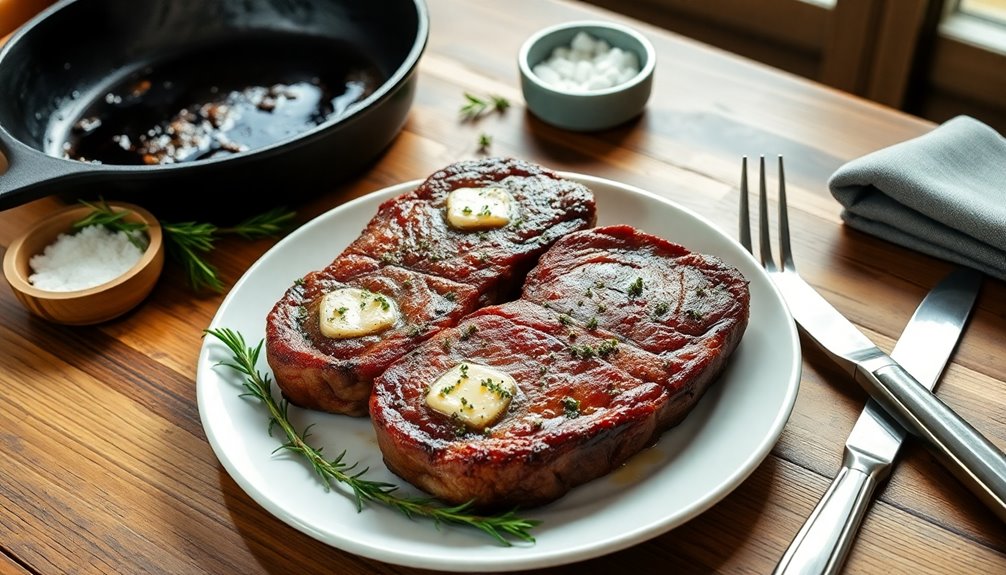
As you consider your next meal, remember that ribeye steak offers a delightful combination of flavor and tenderness that's hard to beat.
To create the perfect ribeye, choose a steak at least 1 inch thick for best juiciness. Whether you grill to medium or pan-sear, high heat is essential for that beautiful sear.
Season simply with kosher salt and black pepper, allowing the delicious ribeye's natural flavors to shine. For an extra boost, finish with a pat of unsalted butter just before serving.
Don't forget to rest your steak for 5 to 10 minutes after cooking; this step guarantees the juices redistribute, giving you a tender, mouthwatering experience with every bite.
Enjoy your culinary masterpiece!
Frequently Asked Questions
Is a Ribeye a Good Cut of Steak?
When you're choosing a cut of steak, you want something that's tender, flavorful, and satisfying.
A good cut should have a nice balance of fat, which enhances its juiciness during cooking.
You'll find that some cuts are more forgiving in cooking methods, allowing for versatility.
Ultimately, your preference for flavor and texture will guide your decision, but you can't go wrong with a cut that promises an enjoyable dining experience.
What Is the Best Cooking Method for a Ribeye Steak?
When you're looking for the best cooking method, grilling, pan-searing, and broiling are top choices.
For grilling, preheat your grill to high heat, sear for 3-5 minutes per side, then lower the heat for even cooking.
If you prefer pan-searing, use a cast iron skillet for 2 minutes on each side before finishing in the oven.
Always check the internal temperature, and let it rest for 5-10 minutes to maximize flavor and tenderness.
What Is a Poor Man's Ribeye Called?
When it comes to getting the most bang for your buck, the "Poor Man's Ribeye" is known as the Chuck Eye Steak.
This cut hails from the chuck primal and packs a punch in flavor without draining your wallet. While it may not be as tender as more expensive cuts, it still offers a satisfying taste.
Cook it right, and you'll enjoy a delicious steak experience that won't break the bank!
Is Prime Rib the Same as Ribeye?
No, prime rib isn't the same as ribeye.
While both cuts come from the rib section of the cow, prime rib is typically a larger roast served with the bone intact, whereas ribeye is cut into individual steaks.
Prime rib usually has a higher fat content, resulting in a richer flavor, while ribeye can vary in marbling.









